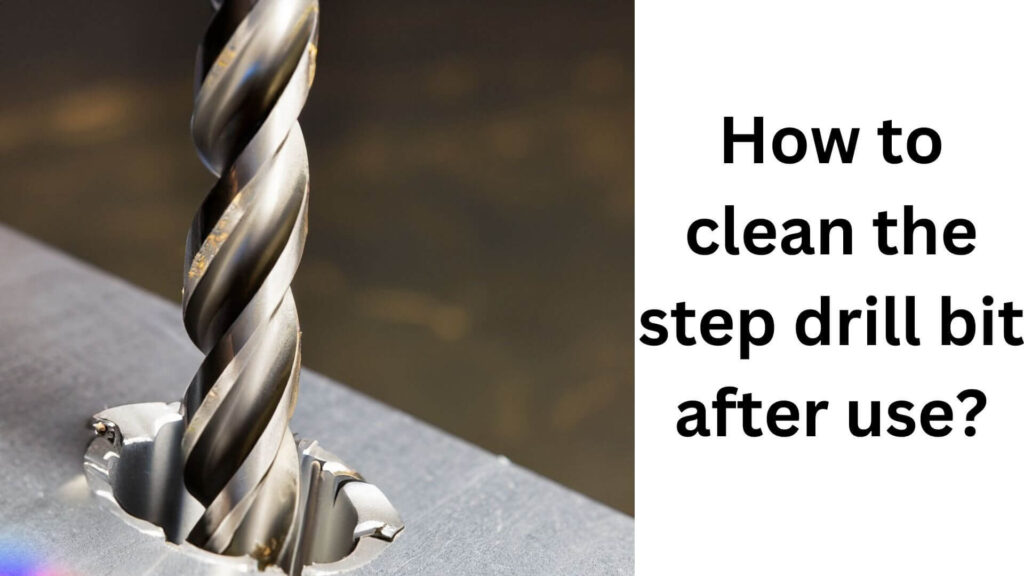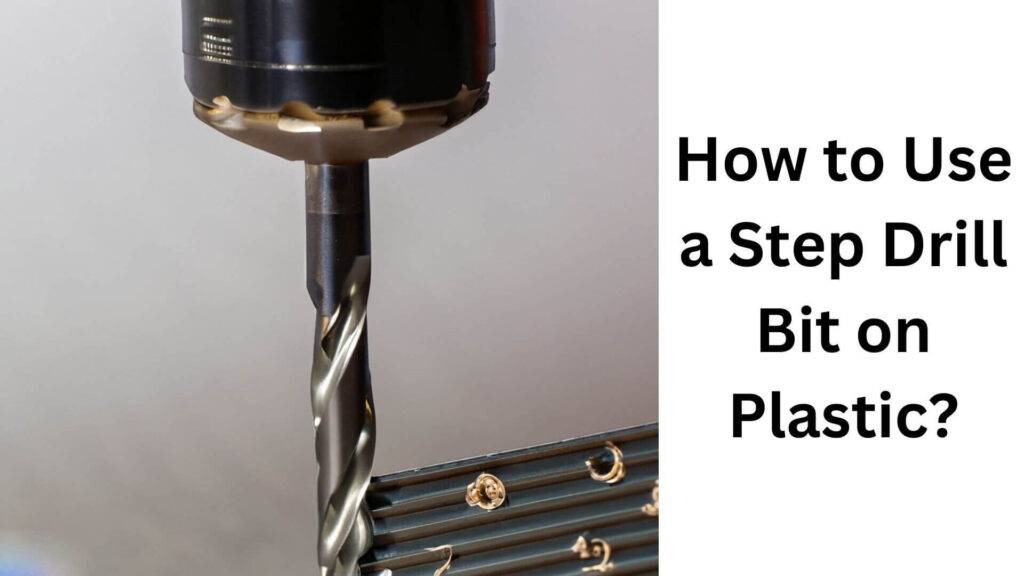Are you tired of cracking and splitting your plastic material while drilling holes? Do you want to learn how to use a step drill bit on plastic without damaging it? Look no further!
- First, I’ll grab your Attention by highlighting the common problems faced while drilling plastic and how a step drill bit can solve them.
- Then, I’ll spark your Interest by explaining the benefits of using a step drill bit and how it differs from traditional drill bits.
- Next, I’ll create a Desire by providing step-by-step instructions on how to use the tool effectively.
- Finally, I’ll motivate you to take action by summarizing the key takeaways and encouraging you to try it out.
In this article, I will guide you through using a step drill bit on plastic with ease and precision. Let’s dive in and learn how to use a step drill bit on plastic like a pro!
Table of Contents
Understanding Step Drill Bits
Step drill bits are must-have tools, especially when working on plastics. These bits are designed to make clean and precise holes in various materials and work exceptionally well on plastics.
Explanation Of The Different Types Of Drill Bits
There are several drill bits, including twist, brad point, spade, Forstner, and step bits. Each bit is designed for a specific type of drilling task. Twist bits are the most common type for drilling holes in wood and metal.
Brad-point bits and spade bits are designed for drilling holes in wood. For example, Forstner bits are used to drill flat-bottomed holes, while step bits are used to drill holes in various materials, including plastic.
Overview Of Step Drill Bit And How It Works
Step drill bits are a series of stepped drill bits combined into one tool. They work by gradually increasing the size of the hole with each step.
This makes them incredibly versatile, as they can create holes of differing diameters without changing the bit.
Step drill bits typically have two flutes that help to clear away the debris as you drill, resulting in a cleaner, more precise hole.
Check Also: Top Drill Bit Recommendations for Working with Plastic
Discuss How Step Drill Bit Benefits Over Regular Drill Bits
Step drill bits have a range of benefits over regular drill bits, including:
- Versatility: With a single tool, you can drill different-sized holes without changing the bit, saving time and effort.
- Precision: Step drill bits produce more precise holes than regular twist bits because of their design. They also have less chatter and leave a cleaner hole.
- Speed: Step drills can drill faster, without snagging or catching, due to the reduced surface area that comes in contact with the material.
- Reduced friction: Step bits have reduced friction on the material because they put less pressure on the workpiece. Thus, the drilled material requires less force to work with the drill bit.
- Material removal: The efficient flutes on a step bit ensure material removal is faster and cleaner than other drill bits.
Highlight The Benefits Of Using A Step Drill Bit On Plastic
Plastics are notoriously tricky to drill, and using a regular twist bit can cause the material to crack or melt. However, a step drill bit is ideal for plastics, and the benefits include the following:
- No cracks or chips: With a step bit, you can drill clean, chip-free holes into plastic sheets without any cracks or chips. The design of the bit provides a smooth, controlled cut, reducing tool marks on the workpiece.
- Faster drilling: Step drills cut through all types of plastics, from soft to hard, quickly and efficiently. The flute’s design helps keep chips away from the cutting area, reducing heat buildup and ensuring a consistently accurate drilling performance.
- More efficiency: Step bits on plastic sheets helps to prevent any slipping of the drill, which can spoil the entire work. These bits are manufactured with a hard or brittle material suitable for working with plastics and provide a better and more precise chip evacuation. They work best at high speeds that prevent clogging and allow you to finish more efficiently.
A step drill bit is a versatile tool that offers a range of benefits over other types of drill bits. They are ideal for working on plastics as they provide precise and clean holes without cracking or chipping the material.
With their fast drilling speeds and efficient chipping, using a step drill bit to create plastic holes is the perfect solution to your drilling needs.
Read More: Wood Drill Bits on Plastic: Compatibility and Considerations
Preparing The Work Area
Discuss The Importance Of Preparing The Work Area
Before beginning to work with a step drill bit on plastic, it is crucial to prepare the work area adequately.
The job can become challenging and hazardous without proper preparation and may cause injuries. Here are some key points to keep in mind when preparing the work area:
- Clear the work area of clutter, debris, or potential safety hazards.
- Choose a flat and stable surface for your workstation.
- Ensure the area is well-lit, allowing you to see the plastic.
- Ensure that the work area is well-ventilated, as melting plastic can release harmful fumes.
Detail How To Create A Safe Work Station
Creating a safe workstation is critical when using a step drill bit on plastic. Here are some tips to help you create a secure workstation:
- Choose an area well away from foot traffic, particularly if you have children or pets.
- Use a large clamp to secure the plastic piece you are working on, ensuring that it is firmly held in place and doesn’t shift, which could cause the drill to wobble.
- Place a wooden piece beneath the plastic, allowing the drill to move through the material more effectively.
- Attach a vacuum cleaner nearby to remove plastic shavings and dust immediately and prevent them from getting airborne.
Provide Tips To Ensure That The Work Area Is Free From Potential Safety Hazards
Safety should be your top priority when working on any project. Here are some tips to ensure that the work area is free of potential safety hazards:
- Make sure to keep gloves and protective eyewear on hand.
- Avoid wearing loose clothing, jewelry, or anything that can easily get caught in the drill bit.
- Restrict smoking, eating, or drinking in the work area since these can cause unnecessary distractions and pose potential hazards.
- Keep sharp or dangerous tools away from reach to avoid unwanted injuries.
Stress The Importance Of Wearing Safety Gear
Appropriate safety gear is crucial to ensure personal protection and safety when using a step drill bit on plastic. Putting on safety gear may take some extra time, but it’s worth the extra effort, as it can save you from potential injuries.
Here is the essential safety gear you need:
- Safety glasses to protect your eyes from debris or dust.
- Safety gloves prevent direct contact between the skin and the plastic material, which can cause irritation or burns.
- Earplugs or earmuffs protect your ears from the high-pitched sound of drilling plastic.
With these simple tips and tricks, working with a step drill bit on plastic can be an easy and successful approach. Preparing the work area, creating a safe workstation, and wearing appropriate safety gear can make the job a breeze.
Read More: Selecting the Correct Drill Bit Size for Plastic Anchors
Step-By-Step Instructions
1. Begin By Measuring And Marking The Spot To Drill
Before you begin drilling, locate and mark the spot where the hole will be created on the plastic surface. Then, measure the hole diameter you’ll need to drill using a tape measure or calipers.
2. Detail How To Choose The Right Step Drill Bit Size For Plastic
After you’ve measured the diameter of the hole, choose the step drill bit size that corresponds to that diameter.
The drill bit should be made of high-speed steel (hss), which is more robust and durable. Avoid using a bit that is too small or too large, as it may damage the plastic surface.
If you need help deciding which size to choose, go with the smaller bit size and work your way up with larger bit sizes as necessary.
3. Explain How To Use A Pilot Hole
Creating a pilot hole is a recommended first step when drilling on plastic. Use a drill bit one size smaller than your step bit to make a tiny hole that will serve as the beginning of the giant hole.
This will help prevent the plastic from cracking or becoming damaged during drilling.
4. Highlight How To Balance Speed And Pressure When Drilling On Plastic Material
When using a step drill bit on plastic, balancing speed and pressure is essential to prevent the plastic from melting or cracking. Instead, use a low-speed setting on your drill, and avoid using too much pressure that can damage the plastic.
Instead of applying pressure to the drill, let the drill do the work by using gentle pressure and allowing the bit to cut through the plastic.
5. Provide Troubleshooting Tips For Common Problems That May Arise
If you’re experiencing difficulty drilling through the plastic, try slowing down the speed of your drill or changing the bit’s size. For example, if the plastic is cracking, try using a pilot hole or adding masking or painter’s tape to the surface before drilling.
Applying water or a lubricant such as wd-40 to the plastic surface may help the bit to cut more smoothly.
By following these step-by-step instructions, you’ll be more likely to achieve a successful drilling experience on plastic. Happy drilling!
Maintenance And Storage
Proper maintenance and storage are essential to extend your step drill bit’s lifespan. Here are some tips to effectively maintain and store your step drill bit:
1. Provide tips for maintaining and keeping the step drill bit sharp:
- To keep your step drill bit sharp and in good condition, follow these maintenance tips:
- After use, clean the bit thoroughly with a soft cloth or brush to prevent dirt and debris buildup.
- Apply some lubricant to the bit’s flutes and shank before using it to reduce friction and heat.
- Avoid using excessive force while drilling, as it can cause damage and blunt the tip.
- Sharpen the bit regularly when you notice it’s not cutting as well as before.
2. Detail how to clean the step drill bit after use:

Cleaning the step drill bit properly after use is crucial to prevent it from getting rusty or dull. Here are the steps to follow to clean the step drill bit:
- Remove any excess material or debris from the bit’s surface using a cloth or brush.
- Soak the bit in warm water and mild soap for about ten minutes.
- Use a soft brush to gently scrub the bit’s surface to remove any remaining debris.
- Rinse the bit in clean water and dry it with a clean cloth.
3. Highlight the importance of proper storage to maintain the quality of the bit:
Proper storage of your step drill bit is as essential as adequate maintenance. Here’s why you should store your bit correctly:
- When stored correctly, your bit is less likely to get damaged or corrupted and will remain sharper for longer.
- Store your drill bit in a dry and cool place, away from direct sunlight, heat, and moisture.
- Avoid storing the bit with other tools that can cause damage or scratches to its surface.
4. Discuss when to replace the step drill bit:
Even with proper maintenance and storage, the step drill bit will eventually wear out and become unusable. The following signs indicate that it’s time to replace your bit:
- The tip is chipped or blunt and doesn’t cut cleanly.
- The bit’s shank or flutes are damaged or worn.
- The bit wobbles or drifts while drilling.
Remember, a damaged or worn-out step drill bit won’t cut precisely and could damage your plastic materials. Therefore, replacing a worn-out bit with a new one is wise.
Frequently Asked Questions Of How To Use A Step Drill Bit On Plastic
What Is A Step Drill Bit Used For On Plastic?
A step drill bit is used to create holes of different sizes in plastic.
What Rpm Should I Use When Drilling Plastic With A Step Drill Bit?
Start with a slow rpm (around 2000) to prevent melting or cracking of the plastic.
Can A Step Drill Bit Be Used On Other Materials Besides Plastic?
It can be used on various materials such as wood, metal, and PVC.
What Safety Measures Should I Practice When Using A Step Drill Bit On Plastic?
Always wear safety goggles and a face shield to protect your eyes from debris.
Can A Step Drill Bit Be Sharpened?
It can be sharpened using a bench grinder or a file to maintain its cutting edge.
In Summary
Finally, using a step drill bit on plastic can be easy if you have the proper tools and techniques. Always use safety gear and carefully choose the right size and type of step drill bit for the job.
Remember to go slowly and allow the bit to do the work, keeping the plastic lubricated with water or oil as you work. And if you encounter any issues or problems, don’t hesitate to stop and reassess the situation.
With patience and practice, you can become an expert at using step drill bits on plastic and achieve professional-looking results.
So, the next time you have a plastic project, try it and enjoy the satisfaction of a job well done. Happy drilling!

Hey, I am MD Hrithik Hossain, I’m a huge fan of DIY crafts. My workshop is where I spend most of my spare time, and I’m always working on some project. To that end, I’d like to share some of my knowledge and experience with you in power tools, woodworking, and other specialized materials fabrication.
I will guide you with genuine knowledge that can assist you with deciding whether a drill is appropriate according to your requirements or not. If you want to find the best drill and know which type of drill is most suited for your needs, then I can guide you with my expertise. My passion lies in helping others find the correct products they need at an affordable price.


